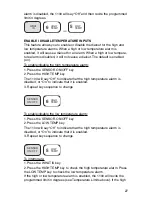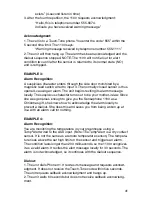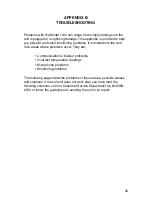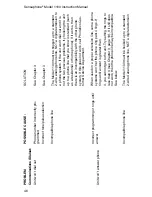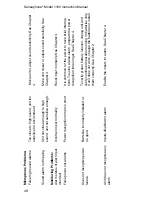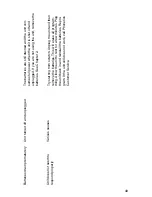
41
exists.” (4-second listen in time)
3. After the fourth repetition, the 1100 requests acknowledgment:
“Hello, this is telephone number 555-5674.
Indicate you have received warning message.”
Acknowledgment:
1. The call is to a Touch-Tone phone. You enter the code “555” within the
5 second time limit. The 1100 says:
“Warning message received by telephone number 555-1111.”
2. The unit will then hang up. The alarm has been acknowledged and the
dialout sequence stopped. NOTE: The 1100 will not dial out for alert
condition two until after the sensor is returned to its normal state (NO)
and is retripped.
EXAMPLE 3:
Alarm Recognition:
A suspicious character enters through the side door monitored by a
magnetic reed switch wired to input 3. The normally closed sensor is thus
opened, causing an alarm. The unit begins reciting its alarm message
locally. The suspicious character turns out to be your mother-in-law. Since
she was generous enough to give you the Sensaphone 1100 as a
Christmas gift, she knows how to acknowledge the alarm locally to
prevent a dialout. She does this and saves you from being woken up at
3
AM
with an alarm call for nothing.
EXAMPLE 4:
Alarm Recognition:
You are monitoring the temperature in your greenhouse using a
TempºAlert wired to the AUX input. (Note: The TempºAlert is a dry contact
sensor. It is not the same as a remote temperature sensor.) The tempera-
ture rises above the set high limit on the sensor and triggers an alarm.
The condition lasts longer than 200 milliseconds, so the 1100 recognizes
it as a valid alarm. It recites the alert message locally for 30 seconds. The
alarm is not acknowledged, so it continues with the dialout sequence.
Dialout:
1. The unit dials Phone #1. It recites its message and requests acknowl-
edgment. It does not receive the Touch-Tone code within five seconds.
The unit requests callback acknowledgment and hangs up.
2. The unit waits 60 seconds but does not receive callback acknowledg-
ment.

